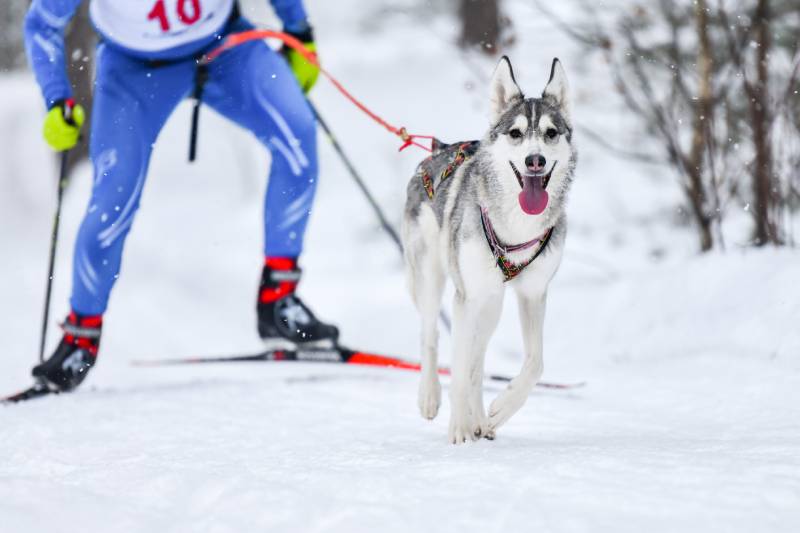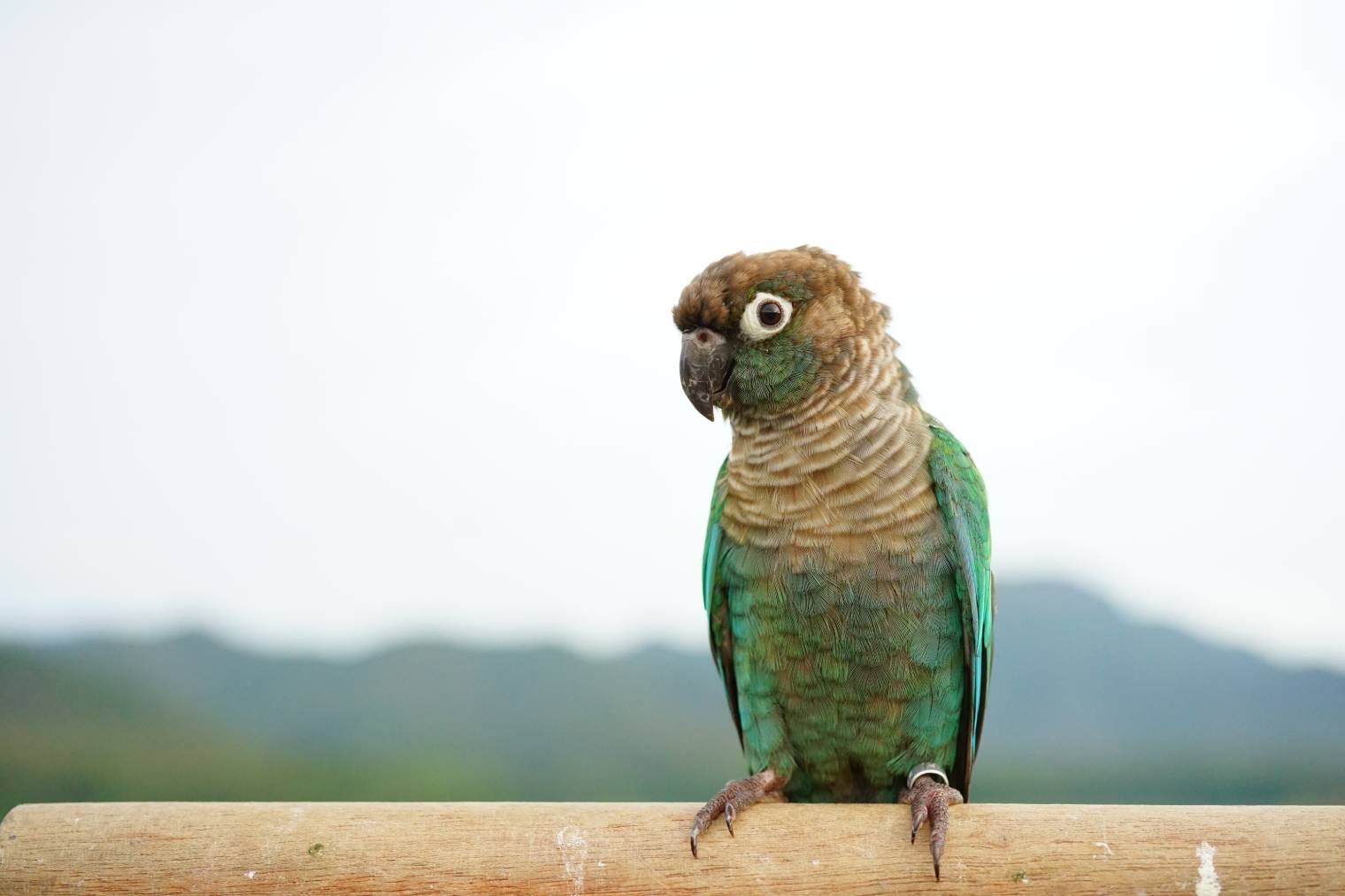VET APPROVED

The information is current and up-to-date in accordance with the latest veterinarian research.
Learn more »Click to Skip Ahead
Skijoring is a dog-powered sport heavily influenced by dog mushing. However, instead of requiring a sled and a pack of dogs, skijoring involves one or more dogs pulling a skier on cross-country skis. Think of skijoring as a leveled-up way to take your dog out for a walk, but instead, the tables are turned, and your dog will essentially be taking you out for a walk.
Typically, winter sports are performed by Arctic dog breeds, but any dog with the appropriate physical build, endurance, and coat type can participate. But because it is a sport, you still need to do some degree of training with your pup before heading out on the trails to try your hand at it.
Keep reading to learn everything you need to know about this great recreational winter activity.

How Does It Work?
The sport’s name, skijoring, comes from the Norwegian word skikjøring, which literally translates to “ski driving.” If we take away all the technicalities of the sport and look at what it is at its most basic, skijoring is simply pairing cross-country skiing with a towing agent. You don’t necessarily have to skijor with dogs; it can be done with horses, reindeer, or even motorized vehicles.
When skijoring, both the human and the dog wear harnesses that are connected with a tow line. The dog runs through the snow, pulling the human behind them. This sport can be done with just one dog or up to four.
Skijoring has been influenced by dog sledding, but there are no whips or reins involved at all; instead, it relies heavily on the enthusiasm of the pup. The human will supply some power with their skis and poles, just as a normal cross-country skier would.
As with dog sledding, the dog is directed through voice commands that tell it when to stop, start, slow, and turn.
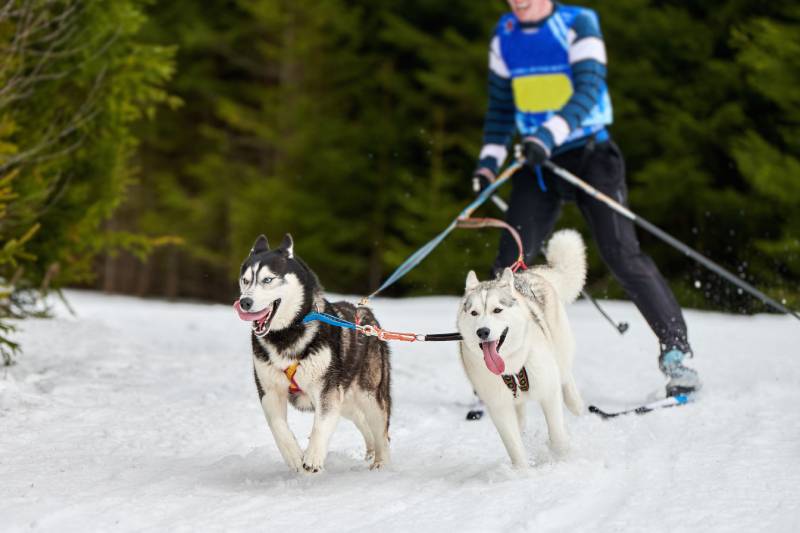
What Kind of Equipment Is Necessary for Skijoring?
Skijoring isn’t a sport you can do without the right equipment and gear.
Your dog will need a skijoring harness system and protection against the cold and snow. A high-quality skijoring kit should include a harness, a belt that goes around your hip, and a shock-absorbing towline that will attach your hip belt to your dog’s harness. Please note that a skijoring harness is not a classic collar or harness that you’d use for walking your dog. Instead, it’s a specialized piece of equipment designed specifically for the sport.
Dogs could wear booties to protect them from snow and ice chunks. You might also wish to invest in a wax paw ointment to prevent any cracking or dryness from exposure to the elements. Depending on your dog’s breed, coat thickness, or preferences, you might also want it to wear a warm jacket.
You will need a set of classic skis and poles, along with high-quality and warm winter boots that work with your ski bindings. In addition, you’ll want to wear proper clothing for winter adventuring, including base and mid layers, a wind-blocking outer layer, warm socks, a hat, and gloves.
Where Did Skijoring Originate?
The word skijoring comes from the Norwegian word skikjøring, which means ‘ski driving,’ and the Sámi people (indigenous people across Scandinavia) used skijoring as a method of travel during the harsh and snow-covered winter months for hundreds of years before this practical method of transportation was repurposed as a sport. The original animal used for this sport was reindeer, and people were towed behind them on wooden skis.
Skijoring behind reindeer debuted at the Nordic Games in Sweden in 1901, and by 1912, skijoring behind horses became popularized in France and Switzerland.
In 1924, equine skijoring was played during the International Winter Sports Week in France, which set the stage for the sport’s inclusion during the second Olympic Winter Games held in Switzerland in 1928.
The equine version of skijoring made its way to the United States after American tourists fell in love with the sport after being exposed to it in places where it was widely offered as a recreational activity.
This sport is still very popular, with over 30 skijoring races throughout the U.S. and Canada set for this winter. In addition, Reindeer skijoring races still occur today in some areas of Scandinavia.
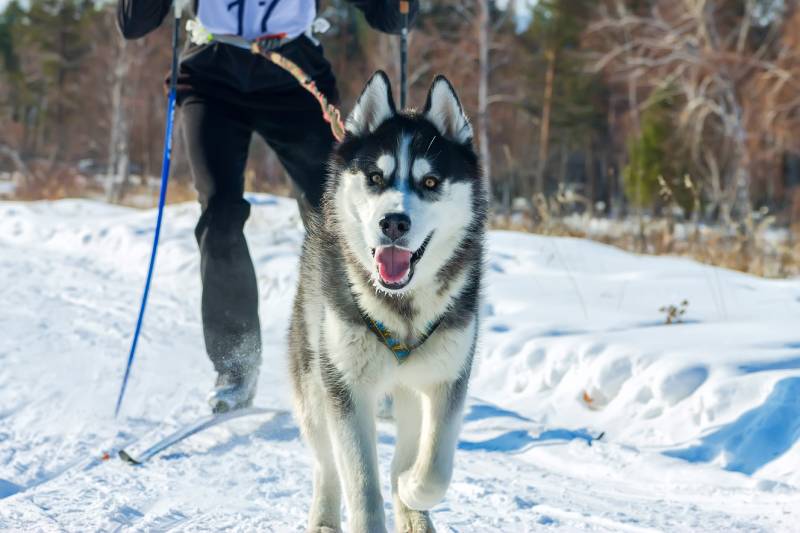

Advantages of Skijoring
Skijoring is a great recreational winter sport for many reasons.
It’s a great hybrid activity perfect for dogs and humans that love the winter months. It can break up the monotony of those cold winter days, providing both owner and dog with a fantastic bonding experience and great exercise.
While no specific breed is required to participate, skijoring organizations recommend that dogs weigh at least 35 pounds (16 kilograms) for safety reasons.
Disadvantages of Skijoring
The biggest disadvantage of skijoring is the specialized equipment necessary for participation. For obvious reasons, you can’t use a standard collar and leash, so you’ll need to spend some money on the proper gear, which can be expensive. This may be a roadblock for some people interested in skijoring, as it’s something that needs planning and training before it can be attempted.
Another disadvantage of the sport is that your dog needs to have a certain amount of training to participate. As we’ve mentioned before, skijoring is not a sport you can decide to try one morning and expect to be out on the trails that same day. Your dog will need to learn commands off-skis before you can successfully enjoy the sport.
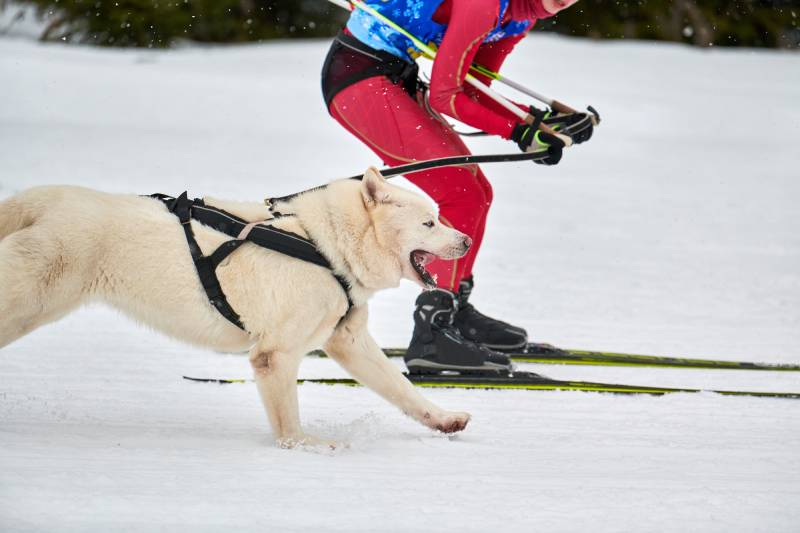

Frequently Asked Questions (FAQ)
Can any dog go skijoring?
Unfortunately, not every dog is cut out for the sport, but this isn’t a sport reserved only for dog mushing breeds like Alaskan Malamutes and Siberian Huskies. Dogs must weigh at least 35 pounds and should love to run, be obedient during training, and respect other dogs and unfamiliar people.
The key is ensuring your dog is interested in participating and healthy enough to do so. Your dog should be at least a year old, healthy, and regularly active.
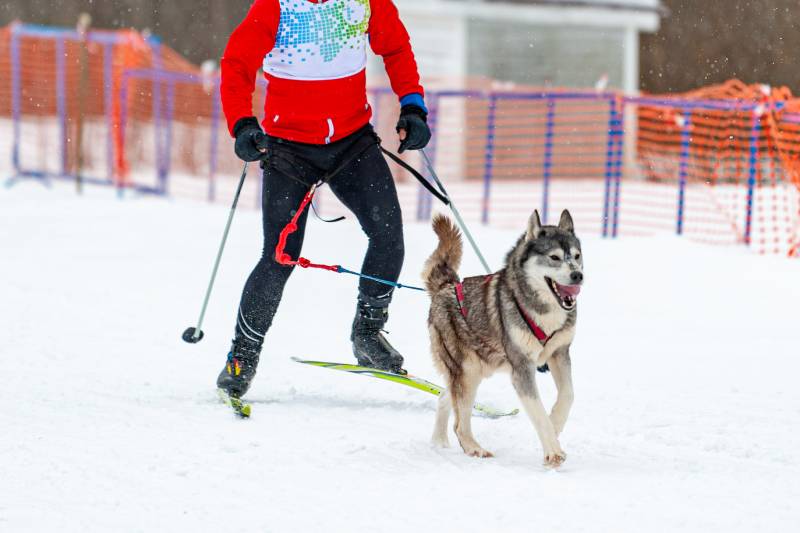
How can I introduce my dog to skijoring?
Before you strap your dog into the gear necessary for skijoring, check with your vet first. They should do a physical exam to see if your pup is ready to begin a pulling sport like this. As mentioned above, most vets won’t recommend dogs under the age of one to participate as they are still growing.
When you get the green light from your vet, feel free to strap your dog into its gear and start training. We recommend practicing the cues you’ll use while skijoring in a large, open area. You can even begin training before there’s snow on the ground.
Will I be able to participate in this sport?
Skijoring is an accessible sport for many people, but it does require a basic level of physical ability and skiing skills. While it’s generally low-impact, falls can still happen, and snow may not always provide a soft landing.
We recommend getting comfortable on skis before you start skijoring with your pup. Go cross-country skiing until you’re comfortable maneuvering and stopping on your skis.

Conclusion
Skijoring is a fun, hybrid winter sport that provides a fantastic opportunity to exercise in those chilly months of the year. While most medium to large dogs can participate, this activity is best left to dogs in good physical condition, obedient, socialized, and with an enthusiasm for learning. The same rules apply to the humans interested in the sport; they need to be in good health, as this is an endurance activity that can be highly demanding on the body. We recommend having a physical done for both you and your dog before you fully commit to the sport and spend all the money on buying the proper gear.
If you’re given the green light to try skijoring, start training yourself and your pup in the off-season so that by the time the snow starts flying, you’ll both be ready to hit the trails.
Featured Image Credit: travelarium.ph, Shutterstock
